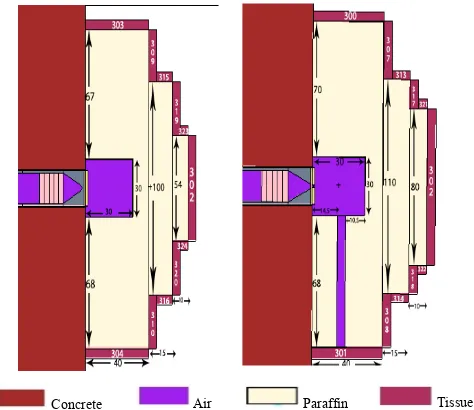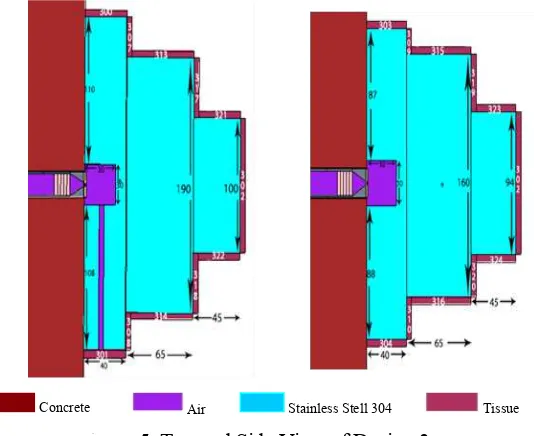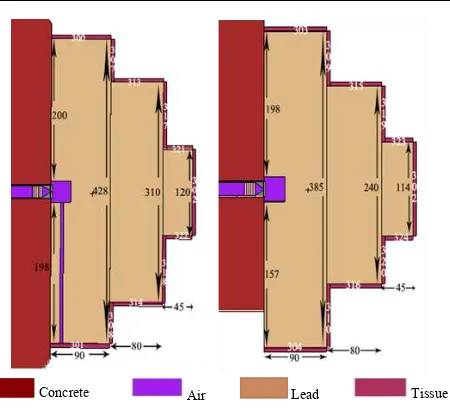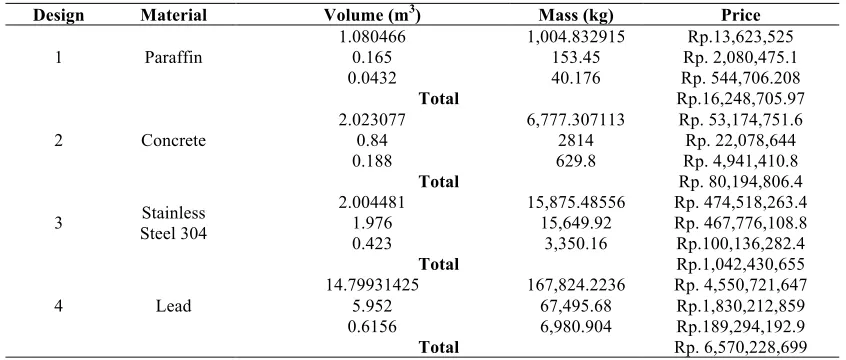139 OPTIMIZATION OF BIOLOGICAL SHIELD FOR BORON NEUTRON CAPTURE
CANCER THERAPY (BNCT) AT KARTINI RESEARCH REACTOR
Gani Priambodo1, Fahrudin Nugroho1, Dwi Satya Palupi1, R. Zailani2, Y. Sardjono3 1Department of Physics, Gadjah Mada University,
Sekip Utara, Bulaksumur, Sinduadi, Mlati, Yogyakarta 55281 2Department of Physics, Semarang State University, Kampus Unnes Sekaran, Gunungpati, Semarang, Jawa Tengah 50229
3Center for Accelerator Science and Technology, National Nuclear Energy Agency (BATAN), Jl. Babarsari, Kotak Pos 6101 Ykbb, Yogyakarta 55281
Diterima editor: 26 Agustus 2017 Diperbaiki: 23 September 2017 Disetujui untuk publikasi: 3 Oktober 2017
ABSTRACT
OPTIMIZATION OF BIOLOGICAL SHIELD FOR BORON NEUTRON CAPTURE CANCER THERAPY (BNCT) AT KARTINI RESEARCH REACTOR. A study to optimize a model of neutron radiation shielding for BNCT facility in the irradiation room has been performed. The collimator used in this study is a predesigned collimator from earlier studies. The model includes the selection of the materials and the thickness of materials used for radiation shield. The radiation shield is required to absorb leaking radiation in order to protect workers at the threshold dose of 20 mSv/year. The considered materials were barite concrete, paraffin, stainless steel 304 and lead. The leaking neutron radiation dose rates have been determined using Monte Carlo N Particle Version Extended (MCNPX) with a radiation dose limit rate that is less than 10 µSv/hour. This dose limit is in accordance with BAPETEN regulation related the threshold dose for workers,in which the working duration is 8 hours per day and 5 days per week. It is recommended that the best model for the irradiation room has a dimension 30 cm width, 30 cm length, 30 cm height and a main layer of irradiation room shielding made from the material paraffin which is 68 cm thickness on the left side and bottom of the irradiation room, 70 cm thickness on the right side of the iradiation room, 45 cm thickness on the front of the irradiation room and 67 cm thickness on the top of the irradiation room. The additional layers of 15 cm and 10 cm thickness are used along with paraffin in order to reduce the intensity of primary radiation from piercing the beamport after two primary layers. There is no neutron radiation leakage in this model.
Keywords: Radiation shielding, BNCT, MCNPX, radiation dose rate, piercing beamport.
ABSTRAK
OPTIMASI PERISAI RADIASI NEUTRON FASILITAS RUANGAN IRADIASI UNTUK BORON NEUTRON CAPTURE CANCER THERAPY (BNCT) DENGAN SUMBER BEAMPORT TEMBUS REAKTOR KARTINI. Telah dilakukan pemodelan perisai radiasi neutron untuk fasilitas Boron Neutron Capture Therapy (BNCT) pada sekeliling ruangan iradiasi. Pemodelan mencakup pemilihan bahan dan tebal yang digunakan untuk perisai radiasi. Perisai diharuskan mampu menahan radiasi yang keluar ruangan sehingga dosis radiasi berada di bawah ambang dosis bagi pekerja radiasi sebesar 20 mSv/tahun. Bahan yang dipertimbangkan adalah beton barit, paraffin, stainless steel 304 dan timbal. Perhitungan laju dosis neutron epitermal dilakukan dengan menggunakan program Monte Carlo N Particle Version Extended (MCNPX) dengan batasan laju dosis radiasi kurang dari 10 µSv/jam, sesuai dengan peraturan Kepala BAPETEN mengenai batas ambang laju dosis pekerja radiasi, dengan asumsi perhitungan waktu kerja 8 jam per hari dan 5 hari per minggu. Desain pertama dari empat desain yang telah dibuat kemudian dipilih sebagai desain yang direkomendasikan dengan laju dosis di bawah batas ambang 10 µSv/jam. Ruangan iradiasi memiliki dimensi panjang 30 cm, lebar 30 cm dan tinggi 30 cm. Lapisan utama perisai pada desain pertama berbahan paraffin setebal 68 cm pada sisi kiri dan bawah ruangan, 70 cm pada sisi kanan ruangan, 45 cm pada sisi depan ruangan dan 67 cm pada sisi atas ruangan. Paraffin setebal 15 cm dan 10 cm ditambahkan sebagai peredam intensitas radiasi primer dari beamport tembus yang masih cukup besar.
Kata Kunci: perisai radiasi, BNCT, MCNPX, laju dosis radiasi, beamport tembus.
_______________________________
140
INTRODUCTION
Cancer is the leading cause of death worldwide, with a total of 8.2 million deaths in 2012. The most common causes of death by cancer are lung cancer (1.59 million), liver (745,000), stomach (723,000), intestine (694,000), breast (521,000) and esophagus (400,000) [1].
Cancer is formed from damaged cells that should die, but continue to grow instead. These extra cells can divide without stopping and may form growths called tumors. This change is caused by several genetic factors and 3 categories of external agents, i.e. physical causes such as ultraviolet and ionizing radiation, chemical causes such as tobacco components, aflatoxin in food and arsenic in beverages and biological causes, such as infections from viruses, bacteria or parasites.
There are several methods of cancer treatment, depending on the type of cancer. Some types of cancer treatments can include surgery, radiation therapy, chemotherapy, immunotherapy, targeted therapy, hormone therapy, stem cell transplant and precision medicine.
In this research, a model radiation shield for the radiation therapy method called Boron Neutron Capture Therapy (BNCT) is presented. BNCT uses a non-radioactive boron-10 nuclide to capture the thermal neutron which then produce the 10B (n, α) 7Li reaction. The reaction products are 7Li dan 4He which have a short range [2]. The product of the reaction is safe since the distance is only limited to the diameter of a cell [3].
The neutron source for BNCT can be obtained from nuclear reactors or accelerators. Technical document of IAEA explains that sufficient thermal neutron flux is needed to react with boron in the cancer cell. Epithermal neutron is used for the deep-seated tumor, while thermal neutron is used for tumor in the skin surface [4]. Existing BNCT facilities generally use nuclear reactor and accelerator-based neutron sources. In Indonesia there are three nuclear research reactors, all of them are operated by the National Nuclear Energy Agency of Indonesia (BATAN), they are the TRIGA 2000 reactor in Bandung, TRIGA MARK-II (Kartini Reactor) in Yogyakarta, and GA Siwabessy Multipurpose Reactor in Serpong. The Kartini Reactor is currently able to be utilized as BNCT facility [5].
Several studies have been conducted to design the collimator in the beamport of Kartini Research Reactor for BNCT [6-8]. Some of these researches produced designs that meet the IAEA criteria, as the Warfi’s design (2015) which use 5-cm-thick of Ni58 for the relector, 30-cm-thick of S32 for the moderator, 20-cm-thick of Ni60 for a filter, 2-cm-thick of Bi209 for gamma shielding and 3-cm-thick of 6Li2CO3-polyethylene as neutron shielding with the radius of aperture is 8 cm for in
vivo in vitro test purposes. This design produces epithermal neutron flux of 1.13 x 109 n/cm2s1. However, some part of design are still not in accordance with the International Atomic Energy Agency (IAEA) criteria, thus re-optimization need to be done. In contrast, Dwiputra (2015) modeled the radiation shield at the end of the thermal column on a previously designed collimator.
In this research the piercing beamport is used to direct radiation to the irradiation room. This room requires material around it, in order to reduce the radiation under the permitted threshold. The design made must comply with the applicable regulations of BAPETEN number 4 of 2013 article 15, in which the dosage limit for radiation workers should not exceed the value of 20 mSv/year. The radiation dosage resulting from the use of BNCT is essentially due to the interaction of radiation with matter by neutrons, gamma rays, beta and alpha.
In the design process of radiation shield, a design simulation should be performed. It aims to obtain a radiation shielding design with an output file that complies with the IAEA regulation in BNCT and also relates to the security and safety of both patients and workers at the BNCT facility as priority. This simulation was modeled on the Kartini reactor with the exact same specification as the original reactor. This simulation can save the estimated cost of installation of reactor components. In addition, it can avoid the high risk of radiation exposure. Therefore, this study was done by using Monte Carlo N-Particle code (MCNP) Version X program.
141 Geometry and radiation shield materials can be varied to produce an output dosage that meets the BAPETEN requirements.
METHODS
The first stage in geometry modeling was to model reactor geometry. The reactor geometry modeling were done by making an input source, which consist of several parts of the reactor, such as reactor core, lazy susan, reflector and stand in the notepad program. The reactor was covered with a pool of water and coated by concrete on the outside. SSW Card and KCODE were used for reactor criticalization. 100000 particles were simulated with the assumption that reactor criticality is 1, and with the skipped cycles is 60 for total cycles of 1000. Reactor conditions were taken into account to calculate the criticality and the flux of the reactor.
The second stage in geometry modeling was to model the beamport geometry. The beamport used is a piercing beamport. The piercing beamport is formed as an air column that extends to the collimator and ends in the irradiation room. Shielding in the irradiation chamber was the focus of this study.
The third stage in geometry modeling was to model the collimator geometry. The collimator used in this study is a collimator previously designed by Arrozaqi (2013) with the specifications shown in Figure 1.
Figure 1. Predesigned Collimator for Kartini Research Reactor Neutron Source which was used in this study [9]
The fourth stage in geometry modeling was to model the irradiation room. The room used as an irradiation facility has a length of 30 cm, a width of 30 cm and a height of 30 cm that has been adapted to the requirement of BATAN. The simulated room is only a blank space filled with air. Calculation of doses was made using materials that contain soft tissue (healthy tissue) which was placed around the room since the properties of radiation is isotropic, which spreads in all directions. After the fourth stages of modeling were done, then the modeling of input code could be run on the program Visual Editor.
The program was run to calculate reactor criticality and neutron flux yield at the outer ring of the reactor. Afterward, radiation shield modeling was then conducted.
142
RESULTS AND DISCUSSION
Initial doses obtained from MCNPX program are presented in Table 1.
Table 1. Epitermal Neutron Dose Rate Simulation Results Without Shielding
Side Radiation Dose Rate (µSv/j) four materials are simulated against the neutron radiation which comes out of the aperture with a thickness variation from 10 to 200 cm.
Simulation results are presented in graphs to facilitate the assessment of materials. The five simulated cells for tally calculations recording the rate of dose passing through the material are
Left Side of the Irradiation Room Right Side of the Irradiation Room
Front Side of the Irradiation Room Top Side of the Irradiation Room Material thickness (cm) Material thickness (cm)
Material thickness (cm) Material thickness (cm)
143 (e)
Figure 2. Radiation Dose Rate of Irradiation Room (a) on the Left Side (b) on the Right Side (c) on the Front Side (d) Rate on the Top Side (e) on the Bottom Side
Figures 2 (a-e) show that at a thickness of 40 cm, paraffin has the best absorption since it is a good hydrocarbon compound to contain the radiation. All the images also show that concrete is very effective to withstand the rate of radiation dose at thickness of 30-100 cm. Stainless steel 304 has poor neutron uptake in Figures 2 to 6 so it can only dampen the dose rate up to 30 cm in thickness. Nevertheless, stainless steel 304 absorption is still better than lead, which has the worst absorption compared to other materials. Therefore in this research, lead did not use as a material for design.
The design of the radiation shield is made by combining the previously tested materials. Each design uses soft tissue which was divided into 21 sections and placed outside the radiation shield to record the leakage rate of the radiation. Division of soft tissue cells are as follows. Cell number 301, 300, 303, 304, 307 to 310 and 313 to 324 are located on the right side of the room, on the left side of the room, above the room, below the room, and front of the room (beam catcher), respectively.
Design 1 uses the material paraffin with a thickness of 68 cm on the right side and a thickness of 70 cm on the left side as the main layer. An additional layer of paraffin with a thickness of 15 cm and 10 cm after the main layer is used to reduce the rate of the primary dose which is still large after going through the main layer, as in Figure 3.
Concrete Air Paraffin Tissue
Figure 3. Top and Side View of Design 1 Material thickness (cm)
Do
se
R
at
e
(
µ
S
v
/h
)
Paraffin Lead
144
The epithermal neutron dose rates of design 1 obtained using MCNPX can be seen in Table 2.
Table 1. Epithermal Neutron Dose Rate of Design 1
Cell Dose Rate
(µSv/j) Cell
Dose Rate
(µSv/j) Cell
Dose Rate (µSv/j)
300 2.40 309 0 318 0
301 8.20 310 0 319 0
302 1.42 313 0 320 0
303 4.98 314 0 321 0
304 7.24 315 0 322 0
307 0 316 0 323 0
308 0 317 0 324 2.34
Design 2 uses barite concrete as a material with a thickness of 100 cm on the left side and 98 cm on the right side as the main layer. An additional layer of barite concrete with a thickness of 35 cm and located about 25 cm after the main is a layer that is used to reduce the rate of primary dose which is still large after going through the main layer as in Figure 4.
Concrete Air Tissue
Figure 4. Top and Side View of Design 2
The epithermal neutron dose rates of design 2 obtained using MCNPX can be seen in Table 3.
Table 3. Epithermal Neutron Dose Rate of Design 2
Cell Dose Rate
(µSv/j) Cell
Dose Rate
(µSv/j) Cell
Dose Rate (µSv/j)
300 0.00 309 7.55 318 7.41
301 0.00 310 5.51 319 32.01
302 3.05 313 0.63 320 6.37
303 1.17 314 2.50 321 13.27
304 1.17 315 17.59 322 8.13
307 3.11 316 1.87 323 23.67
145 Design 3 uses 304 stainless steel material with a thickness of 110 cm on the left side and a thickness of 108 cm on the right side as the main layer. An additional layer with a thickness of 65 cm and 45 cm after the main layer is used to reduce the rate of primary dose which is still large after going through the main layer as in Figure 5.
Concrete Air Stainless Stell 304 Tissue
Figure 5. Top and Side View of Design 3
Epithermal neutron dose rates of design 3 obtained using MCNPX can be seen in Table 4
Table 4. Epithermal Neutron Dose Rate of Design 3
Cell Dose Rate
(µSv/j) Cell
Dose Rate
(µSv/j) Cell
Dose Rate (µSv/j)
300 0 309 34.47 318 8.08
301 1.58 310 8.78 319 0
302 0 313 4.54 320 4.56
303 0 314 0.00 321 4.84
304 1.25 315 7.37 322 0
307 0.93 316 22.73 323 0.87
308 5.00 317 26.70 324 0.29
146
Concrete Air Lead Tissue
Figure 6. Top and Side View of Design 4
Epithermal neutron dose rates of design 4 obtained using MCNPX can be seen in Table 5.
Table 5. Epithermal Neutron Dose Rate of Design 4
Cell Dose Rate
(µSv/j) Cell
Dose Rate
(µSv/j) Cell
Dose Rate (µSv/j)
300 0.89 309 21.31 318 45.68
301 1.64 310 26.87 319 28.73
302 1.47 313 13.00 320 51.95
303 2.30 314 6.38 321 17.18
304 0.94 315 23.12 322 16.08
307 8.04 316 34.84 323 12.11
308 7.63 317 12.09 324 6.67
The results show that design 1 meets the criteria specified from BAPETEN since there is no leakage of dose rate. Therefore the dose rate on soft tissue under the regulation of BAPETEN is 10.42 µSv/j. The optimal model is chosen based on the largest dose rate, the highest radiation dose rate, the average radiation dose rate and estimate of the material cost for each radiation shield design. The best design chosen is based on a summary of all four designs in Table 6 and price of each shield design which is shown in Table 7 and Table 8, where assuming that 1 USD is equivalent to 13,558 IDR.
Table 6. Summary of all Radiation Shield Designs
Design 1 Design 2 Design 3 Design 4
largest dose rate (µSv/j) 8.20 32.01 34.47 51.95
the highest radiation dose rate (the
number of cell) 301 319 309 320
147 The calculation results show that design 1 has the lowest maximum-radiation dose rate and the smallest average-dose rate. The largest radiation dose rate in design 4 is located in cell 320 which is at the bottom-front shielding beam catcher first layer.
Table 7. Shield Material Price per Kilogram (kg)
Material Price per kilogram
Paraffin Rp.13,558
Barit Concrete Rp. 7,846
Stainless Steel 304 Rp. 29,890
Lead Rp. 27,116
Table 8. Cost Estimate Price All Radiation Shield Design
148
irradiation room [11]. Therefore, this study uses a smaller irradiation space of 30 x 30 x 30 and a 2.5 cm diameter duct for the specimen. The room and the main layer are 2 mm thick aluminum coated to reduce the heat which can cause the paraffin material to melt. Four types of choosen materials were tested on the first design with an additional layer to prevent the dose leakage in up to 4 designs.The calculations of dose rates that have been done on all four designs are still within the scope of neutrons only. Therefore calculation of photon dose rate for each design is still not optimal.
CONCLUSION
Design 1 is considered as the best radiation shield design modeling with piercing beam neutron source for BNCT facility. Its largest radiation dose rate is 8.20 µSv/hr. The highest rate of radiation dose in the first design is still below the threshold allowed by BAPETEN, which is 10 µSv/hr. Therefore, the first design is safe for radiation workers if outside the irradiation facility within a certain time. It is concluded that paraffin can hold neutron radiation. Paraffin, barite concrete, 304 stainless steel, and lead can withstand radiation at a thickness of 40 cm, 50 cm, 60 cm and 180-200 cm, respectively. Design 1 has an irradiated room dimension of 30 x 30 x 30 cm, a radiation shield with paraffin material that has a thickness of 68 cm on the left and bottom, 70 cm on the right side, 45 cm on the front side, and 67 cm on the upper side.
ACKNOWLEDGEMENTS
We would like to thank to the Center for Accelerator Science and Technology, National Nuclear Energy Agency (BATAN) Yogyakarta, Indonesia for supporting this study.
REFERENCES
1. National Cancer Institute. About Cancer: What Is Cancer? [accessed: 19 November 2015]. Available from: https://www.cancer.gov/about-cancer/understanding/what-is-cancer/
2. Rasouli, F. S. & Masoudi, S. F. Simulation of the BNCT of Brain Tumors Using MCNP Code: Beam Designing. Iranian Journal of Medical Physics. 2012. 9(3), pp. 183-192.
3. Sauerwein, W. A. G. Principles and Roots of Neutron Capture Therapy. In: Neutron Capture Therapy. Essen: Springer. 2012. p. 1.
4. IAEA Current Status of Neutron Capture Therapy. Vienna, Austria: International Atomic Energy Agency; 2001.
5. Fauziah, A. A. Conceptual Design of Neutron Collimator in Termal Column of Kartini Research Reactor for Boron Neutron Capture Therapy. Yogyakarta: Department of Engineering Physics Gadjah Mada University; 2013.
6. Pamungkas, V. S. H. Simulasi Rancang Bangun Kolimator pada Beam port tembus Reaktor Kartini untuk Uji In Vivo Boron Neutron Capture Therapy. Yogyakarta: Department of Physics Gadjah Mada University; 2016.
7. Maharani, C. Perancangan Kolimator Singgung pada Beamport Singgung Reaktor Kartini untuk Boron Neutron Capture Therapy. Yogyakarta: Department of Physics Gadjah Mada University; 2014.
8. Warfi, R. Optimasi Kolimator Kolom Termal untuk Fasilitas Uji In Vivo dan In Vitro Boron Neutron Capture Therapy (BNCT) di Reaktor Kartini Menggunakan Simulator MCNP-X. Yogyakarta: Department of Engineering Physics Gadjah Mada University; 2015.
9. Arrozaqi, M. I. M. Perancangan Kolimator di Beamport Tembus Reaktor Kartini untuk Boron Neutron Capture Therapy. Yogyakarta: Department of Engineering Physics Gadjah Mada University; 2013.
10. Dwiputra, M. I. M. A. Pemodelan Perisai Radiasi Fasilitas Boron Neutron Capture Therapy dengan Sumber Neutron kolom Termal Reaktor Kartini Menggunakan Simulator Monte Carlo N Particle Extended. Yogyakarta: Department of Engineering Physics Gadjah Mada University; 2015.
![Figure 1. Predesigned Collimator for Kartini Research Reactor Neutron Source which was used in this study [9]](https://thumb-ap.123doks.com/thumbv2/123dok/4037392.1980812/3.595.108.519.346.516/figure-predesigned-collimator-kartini-research-reactor-neutron-source.webp)





